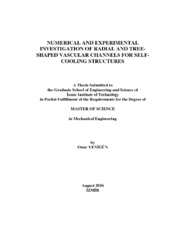Please use this identifier to cite or link to this item:
https://hdl.handle.net/11147/2839Full metadata record
| DC Field | Value | Language |
|---|---|---|
| dc.contributor.advisor | Çetkin, Erdal | - |
| dc.contributor.author | Yenigün, Onur | - |
| dc.date.accessioned | 2017-01-24T07:58:53Z | |
| dc.date.available | 2017-01-24T07:58:53Z | |
| dc.date.issued | 2016-08 | - |
| dc.identifier.citation | Yenigün, O. (2016). Numerical and experimental investigation of radial and tree-shaped vascular channels for self-cooling structures. Unpublished master's thesis, Izmir Institute of Technology, Izmir, Turkey | en_US |
| dc.identifier.uri | http://hdl.handle.net/11147/2839 | - |
| dc.description | Thesis (Master)--Izmir Institute of Technology, Mechanical Engineering, Izmir, 2016 | en_US |
| dc.description | Includes bibliographical references (leaves: 49-51) | en_US |
| dc.description | Text in English; Abstract: Turkish an English | en_US |
| dc.description | xi, 51 leaves | en_US |
| dc.description.abstract | In this study, we show experimentally and numerically how a plate which is subjected to a constant heat load can be kept under an allowable temperature limit. Vascular channels in which coolant fluid flows have been embedded in the plate. Three types of vascular channel designs were compared: radial, tree-shaped and their hybrid. The effects of channel design on the thermal performance for different volume fractions (the fluid volume over the solid volume) are documented. In addition, the effects of the number of channels on cooling performance have been documented. Changing the design from radial to tree-shaped designs decreases the order of pressure drop. Hence increase in the order of the convective heat transfer coefficient is achieved. However, tree-shaped designs do not bathe the entire domain. Therefore, additional channels were inserted at the uncooled regions (hybrid design). The best features of both radial and tree-shaped designs are combined in the hybrid of them: the flow resistances to the fluid and heat flow become almost as low as the tree-shaped and radials designs, respectively. Furthermore, this thesis shows how delaying the inlet of the coolant fluid for a given time interval affects the peak temperature. The effect of design on the maximum temperature shows that there should be an optimum design for a distinct set of boundary conditions, and this design should be varied as the boundary conditions change. This result is in accord with the constructal law, i.e. the shape should be varied in order to minimize resistances to the flows. | en_US |
| dc.description.abstract | Bu çalışmada, sabit ısı yüküne maruz kalan bir plakanın, kabul edilebilir bir sıcaklık altında tutulabileceği, sayısal ve deneysel metotlar kullanılarak gösterilmektedir. İçinden soğutucu akışkan geçen vasküler kanallar plakanın içine gömülüdür. Çalışma kapsamında radyal, ağaç-şekilli ve hibrit olmak üzere üç farklı vasküler kanal tasarımı karşılaştırılmıştır. Kanal tasarımının ısıl performans üzerindeki etkisi farklı hacim oranlarında (sıvı hacmin, katı hacme oranı) belgelenmiştir. Ek olarak, kanal sayısının soğutma performansı üzerindeki etkisi incelenmiştir. Radyal tasarımdan ağaç-şekilli tasarıma geçildiğinde basınç düşüşünün azaldığı görülmektedir. Böylece ısı transferi katsayısında yükselme sağlanmıştır. Ancak ağaç-şekilli tasarım bütün gövdeyi soğutamamaktadır. Bu nedenle soğutulamayan bölgelere ek kanallar yerleştirilmiştir (hibrit tasarım). Radyal ve ağaç-şekilli tasarımların en iyi özellikleri hibrit tasarımda toplanmıştır. Sıvı ve ısı akışına karşı gelen dirençler sırasıyla ağaç-şekilli ve radyal tasarımlar kadar düşük olarak belirlenmiştir. Bu tezde soğutucu akışkan geciktirildiğinde, maksimum sıcaklığın nasıl etkilendiği de gösterilmiştir. Tasarımın en yüksek sıcaklık üzerindeki etkisi, farklı sınır koşulları için optimum tasarım olması ve bu tasarımın sınır koşulları ile birlikte değişmesi gerektiğini göstermektedir. Bu sonuçlar yapısal gelişim yasası ile uyumlu olup, şeklin akışa karşı gelen dirençleri düşürecek şekilde değişmesi gerektiğini ortaya koymaktadır. | en_US |
| dc.language.iso | en | en_US |
| dc.publisher | Izmir Institute of Technology | en_US |
| dc.rights | info:eu-repo/semantics/openAccess | en_US |
| dc.subject | Vascular channels | en_US |
| dc.subject | Smart materials | en_US |
| dc.subject | Self-cooling | en_US |
| dc.subject | Vascularization | en_US |
| dc.subject | Numerical simulation | en_US |
| dc.subject | Experimental study | en_US |
| dc.title | Numerical and Experimental Investigation of Radial and Tree-Shaped Vascular Channels for Self-Cooling Structures | en_US |
| dc.title.alternative | Kendini-soğutan Yapılar için Radyal ve Ağaç-şekilli Vasküler Kanalların Sayısal ve Deneysel Olarak İncelenmesi | en_US |
| dc.type | Master Thesis | en_US |
| dc.authorid | TR226609 | - |
| dc.institutionauthor | Yenigün, Onur | - |
| dc.department | Thesis (Master)--İzmir Institute of Technology, Mechanical Engineering | en_US |
| dc.relation.publicationcategory | Tez | en_US |
| dc.identifier.wosquality | N/A | - |
| dc.identifier.scopusquality | N/A | - |
| item.openairecristype | http://purl.org/coar/resource_type/c_18cf | - |
| item.languageiso639-1 | en | - |
| item.openairetype | Master Thesis | - |
| item.grantfulltext | open | - |
| item.fulltext | With Fulltext | - |
| item.cerifentitytype | Publications | - |
| Appears in Collections: | Master Degree / Yüksek Lisans Tezleri | |
Files in This Item:
| File | Description | Size | Format | |
|---|---|---|---|---|
| T001473.pdf | MasterThesis | 3.87 MB | Adobe PDF |  View/Open |
CORE Recommender
Page view(s)
252
checked on Mar 31, 2025
Download(s)
62
checked on Mar 31, 2025
Google ScholarTM
Check
Items in GCRIS Repository are protected by copyright, with all rights reserved, unless otherwise indicated.